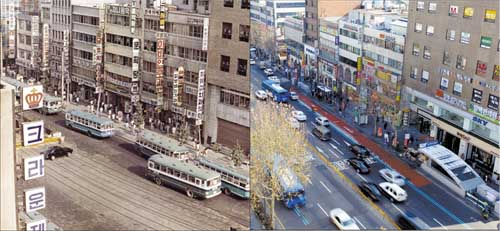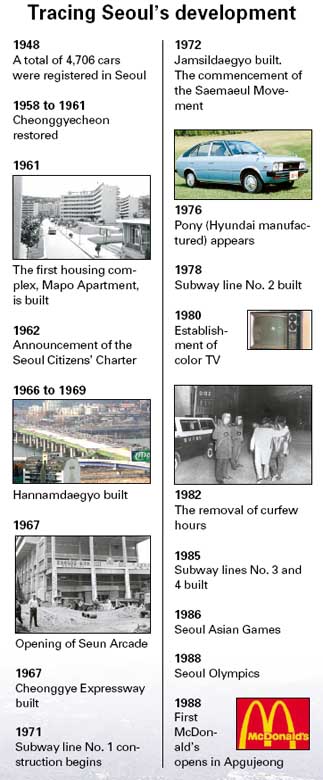Has Seoul lost some soul with rapid change?

Seoul underwent dramatic changes over the past 50 years. A photo taken in the 1970s by Pastor Nomura Motoyuki in Jongno 2-ga, left, and the present-day Jongno, are a sign of stark contrast. Provided by the Cheong Gye Cheon Museum
She recently reminisced about the era when she was a student at Changduk Girls’ High School, located in Jongno-gu, central Seoul. It was the late 1960s and early 1970s, a time of rapid development in Korea.
On a recent stroll through the streets of Jaedong and Waryong-dong, Heo reflected on the changes while visiting Changdeokgung Palace and Biwon, the Secret Garden.
“After school my friends and I always visited the Goryeodang bakery [now Fauchon] located in Gwanggyo and waited for the fresh-baked bread to come straight from the oven,” said Heo, who can still recall the doughy smell.
On a typical morning in 1968, Heo dressed in a navy-blue skirt with a white blouse and wore a ppangdeok hat (a kind of Balmoral) that represented the school.
Her hanok (a traditional Korean house) was located in Sindang-dong, central Seoul, now the site of apartments. The only way to reach Jongno was by taking a crowded local bus since there was no other public transportation.
“When getting on the bus, people jostled for space. It was a nightmare,” she said. She even lost her hat through an open window.
A lifetime Seoul resident, Heo has seen much transformation. She remembers the first subway station built in August 1974. “The first subway line ran from Seoul Station to Cheongnyangni Station” said Heo. “That was a huge change that directly affected my lifestyle since buses weren't as crowded ― what a relief!”
Professor Choi Jong-hyun of the department of urban planning in Hanyang University also remembers the year 1969, when Seoul City stopped using electronic trams.

Choi has been observing Seoul for 40 years and when it comes to the rapid, constant development, he simply sighs.
Seoul was called Hanyang during the Joseon era and Gyeongsungbu during Japanese colonial rule. It was renamed Seoul on Aug, 15, 1945 when the country was liberated from Japan. An independent government was established in 1948. The same year Seoul was selected as the capital of Korea. It was officially named Seoul Metropolis in 1949.
During the Korean War, Seoul residents had to evacuate to Busan. In 1953, when North Korea and South Korea signed an armistice, Seoul was reinstated as the capital.
Mina Park, an educator at the Cheong Gye Cheon Museum in Seongdong-gu, northern Seoul said, “Since 1953, Seoul has been promoting development to establish a city that is both modern and traditional.”
Choi, however, questions if the city has preserved tradition.
“The development was hasty and thoughtless,” Choi said. “As a result, we have today’s real estate problems.”
Heo’s high school, Changduk, was torn down and the Constitutional Court of Korea was built in its place. In February 1989, a new Changduk High School was built in Gangnam, south Seoul, one of the richest areas in Seoul.
During the early 1970s, to prevent over development in the city center, the government moved the so-called high-level schools, including Kyunggi High School, Whimoon High School and Sookmyung Girls High School to southern Seoul.
“The government started developing the southern area,” said Choi. “In 1973, the government selected the Yeongdong area as a development-promoted district.”
He said the government even gave a tax break to those who moved to the south. That was when subway line No. 2 was constructed to link the south and the north.
Amid the city’s development, changes were also being made in housing patterns.
According to the Seoul Development Institute, in 1970 apartments constituted 4 percent of housing, while 88 percent was detached housing. By 2000 apartments became typical housing, constituting 51 percent of total housing, whereas detached housing made up 26 percent.
The first apartment complex was built in December 1961 in Mapo-gu, said Choi. “With the increase of the apartment complexes, more people started investing in land ,” Choi said. During that investment frenzy, Choi criticized the lack of transparency.
Choi said the changes made in certain areas have taken away citizens’ rights to have a nature-friendly environment.
“Myeong-dong is an example,” said Choi. He said that when he visits Myeong-dong in central Seoul, he is surprised at how the alleys and streets that once contained history and tradition have disappeared.
“The indiscriminate development destroyed the parks and squares,” said Choi. “There used to be a central park right across from the Woori Bank building. Instead of greenery, shopping malls and tall office buildings have replaced them.”
But several cultural assets remain in Myeong-dong. The Jung-gu Cultural Center, for example, has record shops like Daihan Music Company, Beethoven Music Company and the 25th Hour. All are at least 30 years old.
Park noted that development was needed to catch up with other western cities. She said Seoul has been promoting several projects. One was the renovation of the ancient stream, Cheonggyecheon.
“The old stream was full of garbage and dirt,” said Park. “It didn’t match well with the other developed parts of Seoul.”
She is positive about the changes she sees in Seoul.
She said that Cheong Gye Cheon Museum has been holding an exhibition of a photo essay by Pastor Nomura Motoyuki, 75, a Japanese man who served as a missionary during the 1960s and 1970s. He took photographs of the developing areas in Seoul, mainly the Cheonggyecheon area.
She said that this exhibition allows people to compare the streets of Seoul to present-day living conditions.
“In the near future, Seun, Daeun, and Poonglim Arcades will be torn down and a 90-meter green track will be constructed,” said Park. “Even though it’s sad to see these traditional sites being destroyed, it’s part of the modernization process.”
Professor Choi, however, is still skeptical about Seoul’s future.
“It’s unbelievable how the city has been ruined,” he said.
“I blame the military regime and political figures for this indiscriminate development.”
He said Seoul has lost its indigenous culture while it was trying to keep up with other cities in the western world.
“In Berlin, buildings cannot be built higher than 22 meters. In Paris, buildings are preserved except in special zones like the La Defense.” He recalled that in the 1970s, Seoul’s tallest building was the 31-floor Samil Building, located in front of the Chohung Bank Headquarters in Gwanggyo, Samillo.
“Speed isn’t everything in developing a city,” said Choi. “There must be a balance between the modern and traditional. Old people like me find this city very difficult to reside in since everything changes so fast.”
By Lee Eun-joo Contributing Writer [estyle@joongang.co.kr]










with the Korea JoongAng Daily
To write comments, please log in to one of the accounts.
Standards Board Policy (0/250자)